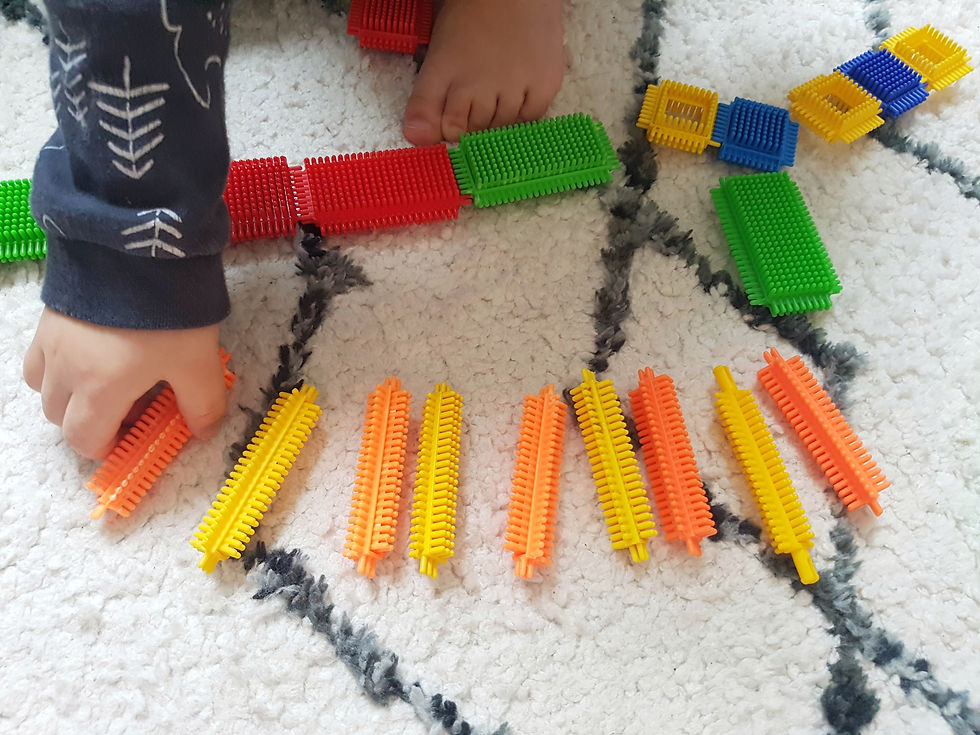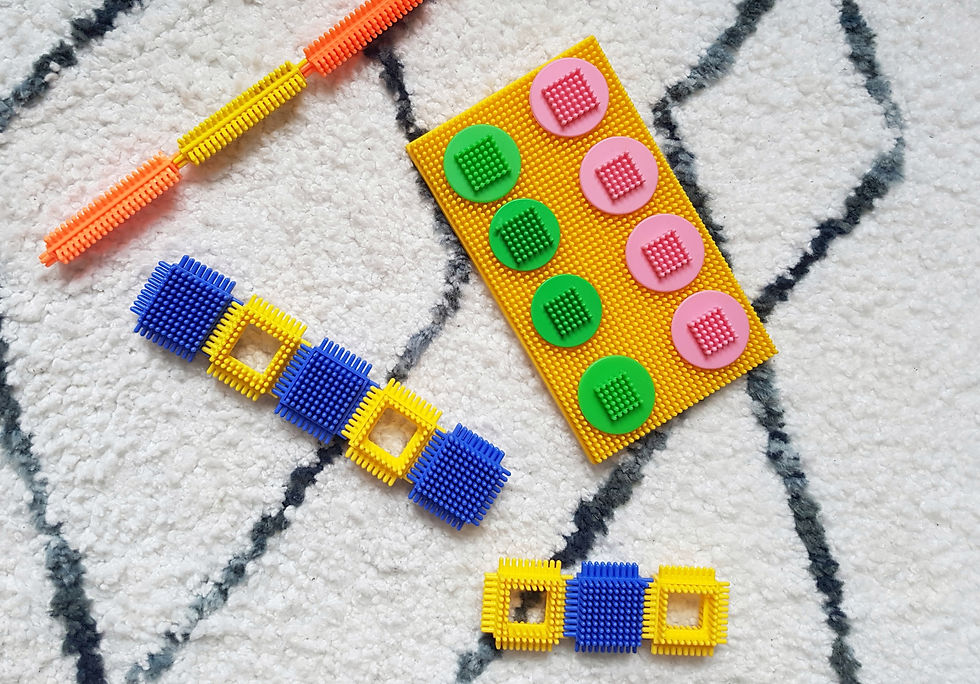Introducing patterns to your toddler
- Vicki Manning

- Feb 24
- 3 min read
Updated: Feb 25
Patterns are everywhere in daily life - from the stripes on a shirt to the rhythm of a song, and I love to give my children the opportunity to explore and create some patterns in their own playful way.

Contains affiliate links - please see our disclosure policy
My favourite way to explore pattern making with my children is by giving them open-ended invitations, whether this is using toys, loose parts or art materials. Open-ended invitations are basically giving your child some resources without any expectation or "rules" about what they are to do with them.
By starting with some objects that have a limited number of features (e.g. 4 shapes, 4 colours, or 4 textures) it naturally invites grouping, sorting and pattern-making.
Introducing patterns at a young stage helps develop develop early mathematical thinking skills; through play toddlers start to recognise repetition, make predictions, and understand logical connections.
Apart from being lots of fun, exploring patterns allows children to see order and structure in their environment, which is crucial for learning things like language, music, and even daily routines.
Reasons to introduce patterns to toddlers:
Early maths development:
Identifying and creating patterns helps your child to understand concepts like sequencing, sorting, and categorisation.
Predictive ability:
By recognising patterns, your child can anticipate what comes next, which develops their ability to make predictions.
Cognitive development:
Pattern recognition stimulates critical thinking skills as you child analyses similarities and differences between objects.
Language skills
Talking about the patterns while your child is playing will help them to develop vocabulary related to colour, shape, size, and sequence.
Multi sensory
Pattern activities can incorporate different textures, colours, and shapes, making learning a multi-sensory experience.
Encouraging curiosity:
Toddlers have an natural interest in finding patterns in their surroundings, and given them opportunites to freely explore encourages that curiosity.
Most imporantly pattern activities are playful and engaging, and make learning enjoyable!
This pattern-making activity is every so simple - I gave my youngest that retro classic Stickle Bricks in a handful of colours, and invited him to make patterns.
I set this activity up in a very informal way, on our living room rug, with Mr 2 still in his comfy PJs.

He started by grouping the stickle bricks by shape and experimenting with how they fit together.
I modelled play a little (modelling play is where you play alongside your child so they can see what can be done with the toys); there was lots of trial and error, but then he then began to stick together the large rectangles in a red green / red green sequence.

He obviously liked this as he went on to stick bricks in a yellow blue / yellow blue sequence, and then some in a yellow orange / yellow orange.

Stickle Bricks are such a great way to introduce patterns to toddler, as they have vibrant colours, a lovely texture and are easy for smaller hands to grasp and manipulate.
Our Stickle Bricks were a second-hand find. We love finding pre-loved toys in charity shops, car boot sales and NCT nearly new sales. If you can't get your hands on some, you can buy them here, or use other building blocks such as Duplo.
Mr 2 then found a board and made a little repeating patterns.

There are so many ways to make patterns playful and fun, here are some other ways you can introduce patterns to toddlers:
Simple repeating patterns
Use everyday objects like blocks or balls to create simple patterns like red-blue, big-small, round-square and talk about whilst playing together.
Songs and rhymes
Incorporate repetitive patterns in songs and rhymes to help your child learn through music. Songs with sequences like Old Macdonald and Wheels on the Bus are perfect for this, as well as songs with repeated actions, like If You're Happy and You Know It.
Sequencing activities
Arrange objects in a specific order and ask your toddler to continue the sequence. Keep it super simple, with only two or three variations.
Patterns in the environment
Point out patterns you can see like the repeating design on a floor or spots on ladybirds; you will discover patterns are everywhere once you start looking!
Creative activities:
Encourage your toddler to create their own patterns using art supplies. Sponge brushes are a really easy way for little hands to get nice results.

How will you enjoy making patterns with you little one? Share your thoughts below!
| Instagram | Pinterest | Howweplayandlearn.com |








Comments